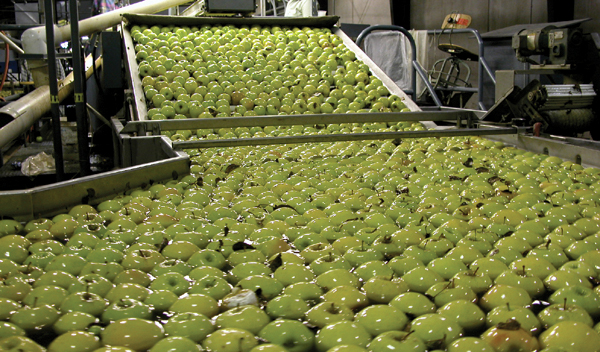There are two main types of packing systems, Commit to Pack (AKA direct pack) and Presizing. For the Commit to Pack system, the warehouse contracts with the grower that they will pack their fruit at the time that the bins are first emptied. A disadvantage of this system is that if the packed fruit is not sold at that time, it will be returned to storage and it may have to be unpacked and sold for processing if there is no order placed for that fruit. For the Presizing system, once fruit are sorted for various sizes, they are returned to bins and placed back into storage until there is a need for that fruit. Presized fruit bins are often made up of pooled grower lots. This may require extra record keeping to maintain the food safety traceability of each grower lot within the pool. Note that apples are generally less sensitive to packing injury than pears (noted below) and can withstand the extra pre-sizing process.

Regardless of the packing system, the basic steps are the same. First, apples are brought out of regular or Controlled Atmosphere (CA) storage when it is time to pack or presize. If the facility uses hydro handling, bins of apples are immersed into a water dunk tank where fruit float out to a conveyor belt. If the facility uses dry loading, full bins are tipped directly onto the conveyor belt. The apples are then moved to the sorting lines, where trained personnel remove and discard the decayed (if they haven’t already been removed), defective, damaged, and undersized fruit. These are referred to as culls. Insect stings, decay, and severe sunburn are all considered culls (learn more). Very small fruit are separated out for disposal or possibly for processing. Apples then proceed to cleaning (soaking in water containing food-grade detergents and disinfectants), rinsing with water and air-drying.
Packing lines vary in the types and amounts of chemicals used in the packing process (learn more). Certain varieties are sprayed with food grade wax to help prevent moisture loss, slow down respiration in storage, and to increase shine. Organic apples are not waxed and undergo a slightly different process (learn more here and here). Fruit is then graded and sized by hand or by using automated optical technology. There are national and state standards for apple grades. Grades consist of appearance, color, size, weight, and internal quality. Some varieties may have various shades of color, all with several grades and sizes. Computer controlled automated sorters are used by many facilities to analyze apple size, color and even internal quality (learn more). After sorting and grading fruit for the Presizing system they are returned to bins labeled specifically for their grade and size then placed back into cold storage until needed to fill an order. Commit to pack fruit proceed directly to the packing area.
Fruit to be packed are sent via conveyor belts to the packing area. Along the way, individual fruit are labeled by machine. The fruit are then placed in trays or bags either by hand or by a packing robot then loaded into boxes. Apples are commonly boxed by size. For example, seventy-two size 72 apples fit in a 42-pound carton. Full containers are labeled with information about variety, size, grade, grower lot number and facility for food safety and traceability. Containers are weighed and placed on pallets and then moved to the shipping area for loading or returned to cold storage if not being shipped right away.
Related Links
- A Brief look at the Washington Apple industry: Past and Present, R. Schotzko and D. Granatstein, pdf report, 78p., 2005.
- Handling Organic Apples. M. McEvoy, Postharvest Information Network page, 1998.
- Stemilt’s Apple Packing page, outlining the apple packing process.
